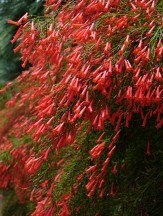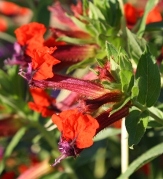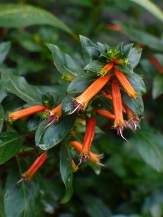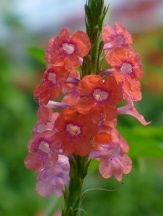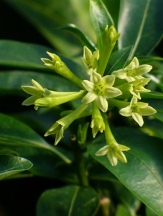Loads of bluish-purple trumpet-shaped flowers are tucked among and atop the narrow dark green foliage from spring to frost all on a low and compact plant. Flowers of the Mexican Petunia attracting bees, butterflies, and other pollinators. Katie Blue Dwarf Ruellia, a selection of R. tweediana or sometimes R. simplex, is a dwarf, root hardy, clump-forming, naturally evergreen tropical that is adorned in narrow deep green, sometimes tinged with purple or bronze tones, weeping foliage creating small individual mounds on their own similar to Liriope. Use this heat and sunloving, shade-tolerant perennial as a border, groundcover, as well as a filler in container gardens. In zones 8-9, Ruellia act like die-back perennials that freeze back and then return from their crown in spring once the weather and soil temperatures begin to properly warm. An insulative but breathable organic mulch will help to ensure their return in areas that experience freezing temperatures. Easy and reliable!
For sheer flower power and durability it is hard to beat the Dwarf Mexican Petunias! These reliable perennials lend themselves to use as a groundcover, as a replacement border plant for the old Monkey Grass and Liriope because they do actually produce flowers over an extended period, and as a low filler or spiller in containers. In mild winter climates, like zone 9 and 10, they can remain evergreen and will flower for most of the year. Here in zone 8B they freeze to the ground in most winters and we plant them atop winter growing bulbs like Spanish Bluebells that take their place during the Ruellia's dormant period and as the Bluebells are finishing up the Ruellias are on their way back to do their thing from late spring until the first hard frost.
The Katie Ruellias are not seed sterile but do typically produce about 1/3 less seed than non-sterile large types. Another advantage to the Katie Ruellia series is that because viable seed germinates best with light exposure, this is especially true for the Katie Blue/Purple and Katie White, so they are less likely to spread via seed in mulched beds. Any resultant seedlings are normally like their parents in growth habit and mature size, although, the flower color may be different.
If your dwarf Mexican Petunias get too tall or leggy just cut them back to a few inches above the ground and they will quickly regrow and soon return to flowering. The Dwarf Mexican Petunias are drought resistant once well established but will also grow in poorly drained moist sites. They are shade tolerant but flower best when grown in sunny areas.
Grows To: 6-12"H x 8-12"W, space at 9-12" apart
This is the average expected mature height by width in feet or inches. Feet are represented by a single quote and inches by a double quote. Parentheses are used to indicate that the plant can potentially reach that dimension, although the sizes outside of the parentheses tend to be more typical. Under poor growing conditions plants may be slightly to significantly smaller, whereas excellent growing conditions can produce larger more vigorous plants.
USDA Cold Hardiness Zones:
8,9,10
USDA Cold Hardiness Zones were established to give gardeners, horticulturists, farmers, nurseries, and landscape architects a universal way to describe where a plant will survive with regard to average winter lows for a region. And these are averages, here in zone 8B ('A' represents the colder half of a zone and 'B' represents the warmer half of the zone and they are separated by about 5oF) we have seen single digits but that is the exception but should be noted by the daring gardener. Each zone is separated by 10oF and the map was updated in 2012. We will continue to use the 2012 map, as the 2023 version is unrealistic. Our zones do not always agree but we try to use our own experience as to what can be depended on to return or have known reputable gardens and or horticulturists to reliably grow that plant in zones that are usually colder but sometimes warmer than what other resources have available. For more on stretching your cold hardiness zones see the ""Growing on the Edge Growing Guide". If you do not know your zone you can find it by clicking on the "USDA Cold Hardiness Zones" link here or above.
Outdoor Light: Full sun, Mostly sunny, Part shade, Part sun
- Full Sun - 8 hours or more of direct sunlight;
- Mostly Sunny - about 6 hours of direct sunlight;
- Partial Shade or Part Shade - about 4 hours of direct sunlight;
- Partial Sun - about 2-4 hours of direct sunlight;
- AM Sun or Morning Sun or Cool Sunlight - cool sunlight like early in the day, like in an eastern exposure, or very late in the day but normally in the shade during the heat of the day;
- Light Shade or Bright Shade - bright indirect sunlight for much of the day;
- Filtered Shade - may receive some amount of direct moving sunlight like through trees but usually not for any extended period especially during the heat of the day;
- Shade or Deep Shade - no or very little direct sunlight, especially not during the heat of the day.
Indoor Light: Direct sunlight is preferred if overwintering plants indoors.
- Direct Sunlight - preferably 4 or more hours of direct sunlight through an unshaded south, east or west facing window;
- High Light - may tolerate no direct sunlight but will need very bright indirect light for 4 or more hours;
- High Indirect Light - bright indirect sunlight for much of the day;
- Medium Light - bright indirect light for 2-4 hours or more;
- Low Light - (few plants can do well under very low indoor light levels but some may tolerate it) no direct sunlight with little bright true sunlight filtering into the area;
- Cool Sunlight or Cool AM(morning) Sunlight - direct sunlight like in an east facing window but not during the heat of the day and will likely also tolerate cool sunlight late in the day, filtered sunlight may also be tolerated.
Beneficial Insects: Bees, Butterflies, and other pollinators
These are the insects that are associated with this plant and are known to utilize it for nectar, pollen, larval or caterpillar food sources, shelter, or any combination thereof. Please note that this is a new entry and we will be working to update it so it's possible that you don't yet see it on other products.
pH Range: Acidic, Mildly Acidic, Neutral, Mildly Alkaline
- Acidic or Strongly Acidic - pH less than 5.5;
- Mildly Acidic - pH 5.6-6.5;
- Neutral - pH 6.6-7.3;
- Mildly Alkaline - pH 7.4-8.4;
- Alkaline or Strongly Alkaline - pH higher than 8.4;
- Note: Acid loving plants that are grown under alkaline conditions often exhibit nutrient deficiencies since the roots are not able to draw some types of minerals from the soil. Gardenias, for instance, may need to be sprayed with chelated iron. Most plants that are native to alkaline soils can be grown in neutral to mildly acidic soils successfully, although the opposite generally is not true.
Soil & Moisture: Average moist, fertile soils with average or better drainage. An organic mulch is recommended but especially in areas where freezes regularly occur. Somewhat drought resistant once well-established.
These are the basic soil types and moisture levels where this plant will survive, not necessarily thrive. Drought resistant plants will need to be well-established, usually 2-3 years at a minimum, in the garden or landscape before they are able to withstand lengthy periods (weeks or months) without supplemental water. Most plants will grow and flower and or fruit best where they have ample moisture and nutrients available during the growing season. With that said, many plants, like prairie natives, are quite adaptable to soil types and can thrive in heavy clay as easily as a loose sandy loam.
Do you know the many benefits of a proper organic mulch? Click here to learn more.
A breathable organic mulch is not only aesthetically pleasing (looks nice) but can:
- Help to improve soil organic matter as it breaks down.
- Provide shade for the soil to help reduce moisture loss and prevent weed seed germination.
- Provide soil microbes, mycorrhizae (beneficial fungi), earthworms,and even nematode predators the necessary organic matter and ecosystem to thrive while their actions aid in improving soil tilth and or friability (think of this as the ease with which roots are able to penetrate the soil).
- Provide insulation to protect the crowns of tender perennials and die-back perennials giving gardeners up to an extra half a zone of winter warmth allowing us to grow that which we normally could not.
- Provide soil temperature moderation preventing premature soil warming in winter and providing a cooler root zone in summer.
- So which mulch is our favorite? Our preferred mulch is Longleaf Pine Straw which has: a natural weed preventative for the first year after it is applied; it is sustainably harvested; and it provides protection from soil erosion and doesn't float away, and yet is still both insulative and breathable; while Longleaf Pine Straw appears to last the longest in the garden and landscape in our opinion as compared to Loblolly.
Flowering Period: Spring to frost to potentially year-round under warm tropical conditions.
These are the times of the year that you can expect this plant to be in flower. Most of the plants that we ship are already of flowering size and may even be in bud or flower when they are shipped but this cannot be guaranteed. The length of time a plant is able to flower is often based on its size. The more mature or better established a plant is the more resources it has to be able to expend on flowering and fruiting. Some perennials, trees, shrubs, and most vines will need about 3 years of establishment to be large enough to begin to meet their true flowering and or fruiting potential. That does not necessarily mean that they will not flower in the interim but they may not be able to flower for as long a time span. The better the growing conditions like having ample available nutrients and moisture generally equates to quicker establishment and longer flowering periods.
Fertilizing: In spring once new growth commences until about midsummer. Year-round under tropical conditions if desired.
In general, plants will require the most nutrients when in active growth and less when dormant. For indoor plants and tropical plants grown in a warm greenhouse or atrium this may be year round. For winter growing perennials, like Louisiana Iris that go dormant in late summer, this may mean fertilizing in fall and winter. For spring and summer growing perennials, and practically all trees, shrubs, and perennial and woody vines in the garden we generally start fertilizing as early as 6 weeks prior to bud break (about Valentine's Day here in zone 8B in Louisiana) and they can be fertilized up to about 6 weeks prior to the earliest expected hard frost or freeze (about mid-August here in our gardens). This allows for tender new growth, and the entire plant really, to "harden off" prior to what could be potentially damaging temperatures and ultimately causing more harm than good.
One of the most common questions that we get is what fertilizer do you recommend? Obviously it will depend on the particular plant but a good quality, slow-release, non-burning fertilizer is what we prefer. Each time it rains or each time you water your plants are getting fed. Most of these fertilizers are either slowly dissolved or osmotically passed through the outer layer of a pellet. We use Scott's Osmocote© 14-14-14 and 18-6-12 on 99% of the plants that we grow, it is more expensive than some fertilizers but we can depend on the results. DO NOT use common garden fertilizers (like 8-8-8,12-12-12) on acid loving plants as it may contain lime as a filler and so can be deadly to plants like Blueberries, Azaleas, and Camellias.
Pruning: During the growing season, if plants grow too tall they can be cut back to a few inches high and will quickly regrow.
Know your plants' needs prior to pruning and not all plants need to be pruned. Selection of plants that will grow to the appropriate size for the given space will help to reduce maintenance like annual pruning. LSU Agcenter uses the apt saying "Right Plant, Right Place".- Woody trees, shrubs, and vines that flower on new growth or new wood are generally pruned in late winter to early spring prior to bud break.
- Woody trees, shrubs, and vines that flower on old wood (last year's growth) are generally pruned once the flowering season has passed and prior to bud set.
- Some woody shrubs (like Spirea, Blueberries, Old Garden Roses) may only need pruning about every third year and then may only need to have the oldest non-flowering stems, dead or damaged wood, and sometimes the small twiggy stems removed. These oldest 'spent canes' are typically removed near ground-level to about 6" high to make way for and to promote the emergence of younger new stems.
- True perennials are typically pruned once the flowering stems have died back after flowering and seed set. Normally we are only removing dead stems once they have turned brown as the plant may reabsorb some of the nutrients in the flowering stems. Dead stems can be removed all the way back to near the crown or back to living healthy stems.
- Tropical and subtropical plants that are grown as die-back perennials (like Lantana and the Confederate Roses in zone 8) are generally pruned once bud break has occurred in spring. The dead stems above the crown may provide some additional protection from the cold and that is why they are left over winter.
- Plants (think perennials, annuals, and biennials) that flower heavily and then begin to look a little ragged due the spent flowering stems may be lightly pruned during the growing season as this will clean them up and the removal of the spent flowering stems and seeds may promote repeat flowering.
- Some perennials, tropicals, and annuals may benefit from periodic 'deadheading'. Often the removal of spent flowers and developing seeds or fruit may promote the production of new flowers but it generally is not a required maintenance.
- ALWAYS use sharp bypass pruners. The anvil type pruners are great for florists who need to crush the stem for water absorption, they are not meant for general use in the garden. A clean cut heals faster and reduces the chance for disease and or die-back to occur. Sterilize your pruners periodically and sometimes even between plants if there is a chance for viruses and or other diseases to be spread between them.
When to Plant: In spring, once all danger of freeze and frost have passed, until about midsummer. Uppot or repot anytime during the growing season.
Preferred planting seasons ranging in order of the most optimum to least optimum times for ease of establishment. Container grown plants, like what we ship, can be successfully transplanted anytime of year as long as proper care is provided. This gives container grown plants an edge on bareroot plants. With that said, there are easier and harder times to establish some plants mainly due to the additional moisture required by the plant during the main growing seasons like spring and summer. If you keep that in mind there is no reason that the great majority of plants can't be added to the garden anytime of year.
Salt Tolerance: Slight
The salt tolerance of plants is a relative description of how tolerant they are to windborne or aerosol and soil borne salt levels. Many plants can tolerate seaside and other coastal habitats or roadsides where deicing has occurred wonderfully while others may die or can simply survive and suffer along. If this does not say specifically that a plant is resistant to windborne or aerosol salts then we simply do not have that data available at this time.
Deer Resistance: Rarely Bothered
Deer resistance is relative to how hungry the deer (or other herbivores) are, what food is readily available in their natural habitat, and how tasty a particular plant is. Few plants are truly completely 100% resistant to being browsed by hungry deer and other herbivores. Please realize that this is just a guide based on our experience and research but some plants may never ever be bothered.Dormant Shipping: Evergreen.
Depending on the time of year and the plant's natural rest period or dormant period and when you request your plants to be shipped you may receive plants in full dormancy. Perennials may only be showing buds at or near ground level, have small crowns, or may have no visible above ground plant parts. Rest assured that we have inspected each and every plant that we ship to ensure that it is an established, healthy, and viable established plant. Dormancy is often the easiest time of year to establish reliably hardy perennials, trees, shrubs, and vines as this is the time of year when demand for moisture and nutrients are typically at their lowest and so they need the least amount of TLC from forgetful gardeners. Tropical plants may be shipped in growth year round but if they are grown as die-back or tender perennials, most should not be planted out until your area is passed all danger of freeze and or frost and the ground temperatures have begun to warm significantly in spring.
Native To / Origin: US Gardens - discovered as a chance seedling in her nursery in Conroe, Texas by Katie Ferguson
If the plant is a true species and not a hybrid or cultivar this shows where it is normally found naturally. There may be some variation in species that are seed grown, which many of our 'species plants' often are, in order to help maintain genetic diversity. If the plant is a "cultivar" (CULTIvated VARiety) and if the data is available, it shows who developed, discovered it, hybridized it, and introduced it as well as the year it was introduced. With cultivars you will also typically see the cultivar name in quotes at the end of the botanical or scientific name. The great majority of cultivars are clonally propagated from division, cuttings, and tissue culture so that they remain true to type so have the same desirable traits as the parent such as growth habit, flower, fruit, or foliage form. With forms (form or forma), varieties (var.), and subforms (subf.) you will see these abbreviations usually between two lower case words at the end of the botanical name. They may be propagated via division or cuttings but can also be grown from seed depending on the plant and what is required to maintain them true to type. Plants that have PPAF(Plant Patent Applied For) or PP followed by a set of numbers, are illegal to propagate clonally for commercial purposes without the implicit permission of the patent holder. Some plants may have the trademark symbol (™) or copyright (©) in the name. These plants may not be clonally propagated and resold under that name without implicit permission from the copyright or trademark holder. Plants may be both patented and trademarked.
Container Plant Growing Guide - includes uppotting, repotting, potting soil selection, proper watering techniques for containers, what does brown or yellow foliage and green soil indicate, and more
See our Planting A New Plant In the Garden or Landscape, How To, and General Growing Guide for basic planting, initial watering and estabishment watering in instructions
The information listed above that has a black arrow symbol, ‣, before the property name is expandable (just click on it anywhere) and it will contain additional details and a more in-depth description of the terms that we use in this plant's description. This information is based on our years of experience both gardening and growing plants, input from other horticulturists, nursery people, gardeners, and research. If you feel we are missing important information about a plant please feel free to share it with us so that we can pass it on.
![]()

